 W
WFort Belknap, located near Newcastle, Texas, was established in November 1851 by brevet Brigadier General William G. Belknap to protect the Texas frontier against raids by the Kiowa and Comanche. It was the northernmost fort in a line from the Rio Grande to the Red River. The fort functioned as a base of operations rather than as a fortified point, and it became the center of a substantial network of roads, including the Butterfield Overland Mail. The fort was designated a National Historic Landmark in 1960, in recognition of its key role in securing the Texas frontier in the 1850s and 1860s.
 W
WBird's Fort was a community north of present-day Arlington, Texas (USA). In 1841, when John Neely Bryan established Dallas, he invited the settlers at Bird's Fort to come live in his proposed city.
 W
WFort Bliss is a Strategic Deployment Platform for the United States Army that executes deployment operations enabling rapid and efficient unit deployment and re-deployment. Simultaneously, Fort Bliss Garrison provides facilities and services through a professional workforce that assists units in sustaining their readiness and promotes a safe and secure installation, empowering soldiers, families, and civilians to thrive.
 W
WFort Brown was a military post of the United States Army in Cameron County, Texas during the later half of the 19th century and the early part of the 20th century. Established in 1846, it was the first United States Army military outpost of the recently annexed state. Confederate Army troops stationed there saw action during the American Civil War. In the early 20th century, it was garrisoned in relation to military activity over border conflicts with Mexico. Surviving elements of the fort were designated as a National Historic Landmark in 1960.
 W
WCamp Barkeley was a large United States Army training installation during World War II. The base was located eleven miles (18 km) southwest of Abilene, Texas near what is now Dyess Air Force Base. The base was named after David B. Barkley, a Medal of Honor recipient during World War I. The camp was 70,229 acres (284.21 km2) in size and had a population of 50,000 at its peak of operation.
 W
WCestohowa is an unincorporated community in Karnes County, Texas, United States. According to the Handbook of Texas, the community had an estimated population of 110 in 2000.
 W
WFort Chadbourne was a fort established by the United States Army on October 28, 1852, in what is now Coke County, Texas, to protect the western frontier and the Butterfield Overland Mail route. It was named after Lt. T.L. Chadbourne, who was killed in the Battle of Resaca de la Palma. It was defended by Companies A and K of the 8th U.S. Infantry. During the early days of the American Civil War, the fort surrendered to the Confederates on February 28, 1861, even before the Confederate shelling of Fort Sumter, South Carolina, but was reoccupied by federal troops from 1865 to 1867.
 W
WFort Clark was a frontier fort located just off U.S. Route 90 near Brackettville, in Kinney County, Texas, United States. It later became the headquarters for the 2nd Cavalry Division. The Fort Clark Historic District was added to the National Register of Historic Places on December 6, 1979. The Commanding Officer's Quarters at Fort Clark were designated a Recorded Texas Historic Landmark in 1988. The Fort Clark Guardhouse became a Recorded Texas Historic Landmark in 1962. The Fort Clark Officers' Row Quarters were designated a Recorded Texas Historic Landmark in 1991.
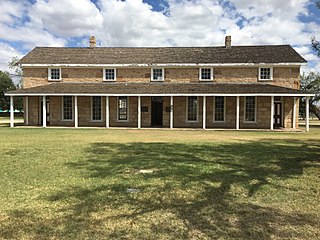 W
WFort Concho is a former United States Army installation and National Historic Landmark District located in San Angelo, Texas. It was established in November 1867 at the confluence of the North and South Concho Rivers, on the routes of the Butterfield Overland Mail Route and Goodnight–Loving Trail, and was an active military base for the next 22 years. Fort Concho was the principal base of the 4th Cavalry from 1867 to 1875 and then the "Buffalo Soldiers" of the 10th Cavalry from 1875 and 1882. The troops stationed at Fort Concho participated in Ranald S. Mackenzie's 1872 campaign, the Red River War in 1874, and the Victorio Campaign of 1879–1880.
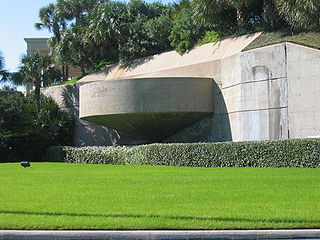 W
WFort Crockett is a government reservation on Galveston Island overlooking the Gulf of Mexico originally built as a defense installation to protect the city and harbor of Galveston and to secure the entrance to Galveston Bay, thus protecting the commercial and industrial ports of Galveston and Houston and the extensive oil refineries in the bay area. The facility is now managed by the US NOAA National Marine Fisheries Service, and hosts the Bureau of Commercial Fisheries Laboratory, the Texas Institute of Oceanography, as well as some university facilities. The area still contains several historical buildings and military fortifications.
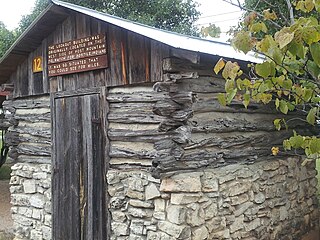 W
WFort Croghan was the third of the first four forts established by the United States government to protect settlers from hostile Indians along the Texas frontier. From its establishment on March 18, 1849, by Lt. C.H. Taylor until it was abandoned in 1855, Fort Croghan was home to Company C, 8th Infantry, U.S.A. (mounted), and eventually became the headquarters of the Second Dragoon Regiment.
 W
WBuilding 98 at Fort D. A. Russell is the historic US army base bachelor officer quarters, officers club, and grand ballroom near Marfa, Texas; it was active from 1911 to 1946. Building 98 is Located at Fort David A. Russell's central fort complex. It is a project of the International Woman's Foundation and it is the home of the World War II German prisoners of war POW murals.
 W
WFort D. A. Russell is the name of an American military installation near Marfa, Texas, that was active from 1911 to 1946. Its namesake is David Allen Russell, a Civil War general killed at the Battle of Opequon, September 19, 1864.
 W
WFort Davis National Historic Site is a United States National Historic Site located in the unincorporated community of Fort Davis, Jeff Davis County, Texas. Located within the Davis Mountains of West Texas, the historic site was established in 1961 to protect one of the best remaining examples of a United States Army fort in the southwestern United States.
 W
WFort Duncan was a United States Army base, set up to protect the first U.S. settlement on the Rio Grande near the current town of Eagle Pass, Texas.
 W
WFort Elliott was a United States Army post in the Texas Panhandle, operational between 1875 and 1890 and named for Major Joel H. Elliott, a casualty of the Battle of Washita River in 1868.
Fort Hancock is an unincorporated community and census-designated place (CDP) in Hudspeth County, Texas, United States. Its population was 1,750 at the 2010 census.
 W
WFort Gates, was a United States Army fort established on October 26, 1849 as Camp Gates by Captain William Reading Montgomery and two companies of the Eighth United States Infantry. The fort was located on the north bank of the Leon River about five miles east of the site of present Gatesville, Texas. The installation was named for Brevet Major Collinson Reed Gates of New York, a noted officer in the Battle of Palo Alto and the Battle of Resaca de la Palma. The fort was established to protect settlers on the Texas frontier from Indians. The fort was garrisoned by companies D, I, F, and H of the Eighth United States Infantry. In April 1851, 256 enlisted men and forty-five officers were stationed at Fort Gates, the most reported in a single month.
 W
WFort Graham was a pioneer fort established in 1849 by Brevet Major R.A. Arnold at the site of Jose Maria Village, an Anadaca camp on the western edge of present-day Hill County, Texas. It remained in service until 1853, when settlements had moved further west. It was named after Col. William M. Graham, who died at the Battle of Molina del Rey.
 W
WFort Griffin, now a Texas state historic site as Fort Griffin State Historic Site, was a US Cavalry fort established 31 July 1867 by four companies of the Sixth Cavalry, U.S. Army under the command of Lt. Col. S.D. Sturgis, in the northern part of West Texas, specifically northwestern Shackelford County, to give settlers protection from early Comanche and Kiowa raids. Originally called Camp Wilson after Henry Hamilton Wilson, a recently deceased lieutenant, it was later named for Charles Griffin, a former Civil War Union general who had commanded, as de facto military governor, the Department of Texas during the early years of Reconstruction.
 W
WFort Lancaster, one in a series of forts erected along the western Texas frontier, is located in the Pecos River Valley, along Live Oak Creek, in Crockett County, Texas, United States. The fort was established by Captain Stephen Decatur Carpenter on August 20, 1855, to guard the military supplies, commercial shipments, and immigrants moving along the San Antonio-El Paso Road. The 82-acre site, now operated by the Texas Historical Commission as Fort Lancaster State Historic Site, contains the ruins of twenty-nine buildings that made up the fort and a visitor center with a museum about the heritage of the fort.
 W
WThe Fort Leaton State Historic Site is located on Farm to Market Road 170, in Presidio County in the U.S. state of Texas. The original adobe structure was a private residence dating back to the early 19th century. It was purchased in 1848 by Benjamin Leaton, who adapted it as a fortress. Fort Leaton was the Presidio County original seat of government. Through murders, financial difficulties and abandonment, the structure changed hands numerous times. In 1967, it was deeded to the state of Texas and opened to the public in 1978 as a Texas State Historic Site. It was added to the National Register of Historic Places listings in Presidio County, Texas on June 18, 1973.
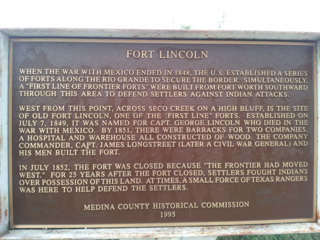 W
WFort Lincoln is a town in Medina County, Texas. It was established on July 7, 1849 by Major James Longstreet, with two companies of the Eighth United States Infantry, after the Mexican–American War. The fort is named in honor of Captain George Lincoln who was killed in the Battle of Buena Vista. The fort was abandoned on July 20, 1852.
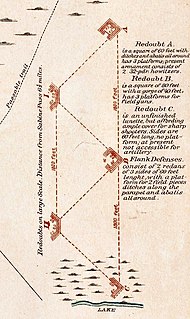 W
WFort Manhassett was a group of earthen fortifications that guarded the western approaches to Sabine City, Texas during the American Civil War, operating in service of the Confederate Army from October 1863 to May 1865.
 W
WFort Mason was established on July 6, 1851, in present-day Mason County, Texas. It was named in honor of George Thomson Mason, a United States Army second lieutenant killed in the Thornton Affair during the Mexican–American War near Brownsville, April 25, 1846. At various times from 1856 to 1861, this was the home fort for Albert Sidney Johnston, George H. Thomas, Earl Van Dorn, and Robert E. Lee. The fort was abandoned by the military in the 1870s, and restored by a group of local citizens in 1975. Visitors can tour the reproduction officers' quarters at the Fort Mason Museum.
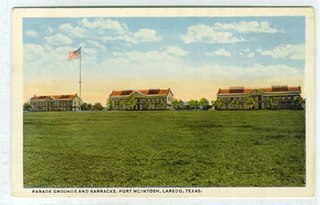 W
WFort McIntosh was a U.S. Army base in Laredo, Webb County, Texas, from 1849 to 1946.
 W
WFort McKavett State Historic Site is located in Menard County, Texas, United States. Fort McKavett was a frontier fort established as Camp on the San Saba in 1852 to protect settlers from Indian raids. The camp was renamed in honor of Captain Henry McKavett, who was killed in the Mexican–American War battle of Monterrey.
 W
WMoore's Fort is a twin dogtrot type blockhouse in Round Top, Texas. Built by John Henry Moore in 1828, it is the oldest building in Fayette County. It was originally located where La Grange is today, as a shelter for settlers from Comanche raids. Later it was moved to Round Top. A historical marker sits at the original location in La Grange.
 W
WFort Phantom Hill was a United States Army and Confederate Army installation located at the Clear Fork of the Brazos River in Jones County, Texas. The fort was active from 1852 to 1853 and again from 1856 until the 1890s.
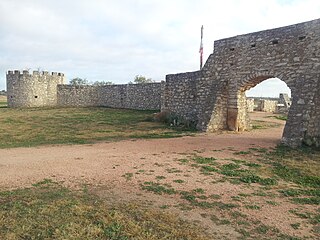 W
WPresidio San Luis de las Amarillas, now better known as Presidio of San Sabá, was founded in April 1757 near present-day Menard, Texas, United States to protect the Mission Santa Cruz de San Sabá, established at the same time. The presidio and mission were built to secure Spain's claim to the territory. They were part of the treaty recently reached with the Lipan Apaches of the area for mutual aid against enemies. The early functioning of the mission and presidio were undermined by Hasinai, also allied with the Spanish, attacking the Apaches. The mission was located three miles downstream from the presidio by request of the monks at the mission to ensure that the Spanish soldiers would not be a corrupting influence on the Lipan Apaches the monks were trying to convert to Christianity. The original presidio and mission were built out of logs.
 W
WFort Quitman was a United States Army installation on the Rio Grande in Texas, south of present-day Sierra Blanca, 20 miles southeast of McNary in southern Hudspeth County. The fort, now a ghost town, was named for former Mississippi Governor John A. Quitman, a strongly pro-slavery politician and leading Fire Eater who served as a major general under Zachary Taylor during the Mexican–American War.
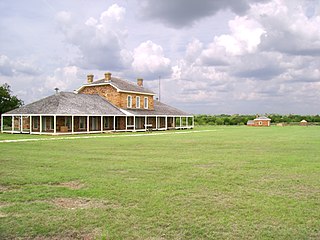 W
WFort Richardson was a United States Army installation located in present-day Jacksboro, Texas. Named in honor of Union General Israel B. Richardson, who died in the Battle of Antietam during the American Civil War, it was active from 1867 to 1878. Today, the site, with a few surviving buildings, is called Fort Richardson State Park, Historic Site and Lost Creek Reservoir State Trailway. It was designated a National Historic Landmark in 1963 for its role in securing the state's northern frontier in the post-Civil War era.
 W
WThe French colonization of Texas began with the establishment of a fort in present-day southeastern Texas. It was established in 1685 near Arenosa Creek and Matagorda Bay by explorer Robert Cavelier de La Salle. He intended to found the colony at the mouth of the Mississippi River, but inaccurate maps and navigational errors caused his ships to anchor instead 400 miles (640 km) to the west, off the coast of Texas. The colony survived until 1688. The present-day town of Inez is near the fort's site. The colony faced numerous difficulties during its brief existence, including Native American raids, epidemics, and harsh conditions. From that base, La Salle led several expeditions to find the Mississippi River. These did not succeed, but La Salle did explore much of the Rio Grande and parts of east Texas.
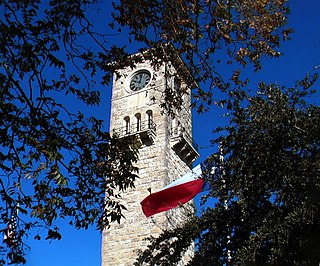 W
WFort Sam Houston is a U.S. Army post in San Antonio, Texas. Known colloquially as "Fort Sam," it is named for the U.S. Senator from Texas, U.S. Representative from Tennessee, Tennessee and Texas Governor, and first President of the Republic of Texas, Sam Houston.
 W
WFort Martin Scott is a restored United States Army outpost near Fredericksburg in the Texas Hill Country, United States, that was active from December 5, 1848, until April, 1853. It was part of a line of frontier forts established to protect travelers and settlers within Texas.
 W
WThe Fort Stockton Historic District, in Fort Stockton, Texas, is a 75 acres (30 ha) historic district which was listed on the National Register of Historic Places in 1973.
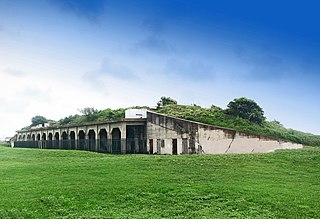 W
WFort Travis Seashore Park is also the historic Fort Travis, a 60 acres (24 ha) military site with bunkers. The park is located in an area known as Bolivar Point, on the extreme west side of the Bolivar Peninsula in Galveston County, Texas.
 W
WFort Wolters was a United States military installation four miles northeast of Mineral Wells, Texas. Originally named Camp Wolters, it was an Army camp from 1925 to 1946. During World War II, it was for a time the largest infantry replacement training center in the United States, and was commanded by Major General Bruce Magruder.